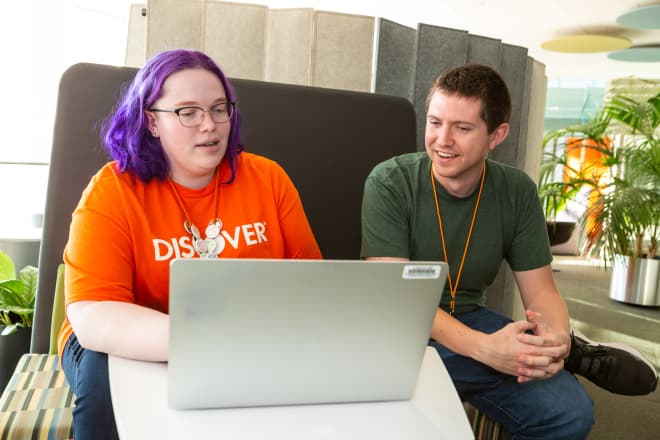This article explores the dynamic landscape of upskilling programs, uncovering hidden treasure of knowledge, and charting a course toward career advancement. From immersive learning journeys to internal conferences, I delve into strategies that Discover has used to empower individuals and teams within Discover to grow their skills and advance their careers.
At Discover, we are product-centric, prioritizing products and their development to meet customer needs. Being product-centric means focusing on creating and improving products as the central aspect of our strategy. We emphasize product excellence, innovation, and market success. In pursuit of this objective, we offer our workforce opportunities for employees to enhance their skills, develop competencies, and invest in professional growth.
What is upskilling?
Upskilling is a continuous process of enhancing one’s knowledge, skills, and competencies in their respective domains. Companies should prioritize upskilling to keep pace with changing job requirements and technological advancements.
A few benefits of prioritizing upskilling include:
- Adapting and embracing change: As technology advances, employees need to keep up with new platforms, tools, and processes.
- Identifying and addressing skill gaps: Identifying the gaps in skillsets of a company's workforce is crucial. Upskilling in these identified domains helps address the shortage of skills within a company, especially as certain roles become more complex. Upskilling an invested employee is often easier than hiring a new employee and training them on the companies’ tools, processes, culture and procedures.
- Employee retention: Offering upskilling opportunities can increase employee engagement and retention. Employees who feel like their employers care about their development and skill-building are more loyal and engaged.
Strategies for workforce upskilling
At Discover, a few strategies that we have found successful for upskilling employees include:
- Skills and competency assessments: Use competency assessments to gauge level of expertise and identify skill gaps. Determine which skills are valuable for your employees’ career advancement and the company’s growth.
- Continuous learning: Create a culture of continuous learning with a wide array of learning options like self-paced courses, mentorship programs, and job shadowing.
- Address skill gaps: Continually assess employees’ skills against business needs to identify and close gaps.
- Peer coaching: Learning from one another is a great way to help foster peer-to-peer interactions and learning.
Examples of upskilling programs at Discover
At Discover, we have numerous ways to upskill our employees. A few specific programs that have been successful include offering;
- Immersive Learning Journeys: Learning paths that have been crafted to be immersive and adaptive. For example, the product owner learning journey at Discover focuses on product delivery excellence with a quality-first mindset. This modality of learning is quite powerful to help with stickiness of the topics being covered.
- Microlearning: The focus is on shorter, smaller learning modules allowing learners to absorb and retain information more effectively. For example, a quiz or an interactive jeopardy style learning opportunity can provide an engaging learning experience for employees
- Internal conferences: A day or multi day, dedicated learning event for specific domains is a great way to help involve the community of employees to partake in learning. For example, Discover hosted its first ever PO Con, an internal conference focused on product owners (PO's). The event was attended by over 400 employees of the PO community. Great energy all around at this conference!
Addressing Challenges
Some of the common obstacle's organizations face during upskilling efforts may include budget constraints, resistance to change, or lack of alignment with business goals. To overcome these challenges, remember to make the upskilling program an integral part of the company's culture and operations.
Keep in mind that upskilling is not a one-time event but a continuous process. We want to be deliberate about encouraging a culture of lifelong learning.
Time is of the essence and there is a finite amount of time in a day. Most often, time is often seen as a constraint to participate in upskilling programs. Key is to balance investment of time in these programs - like starting out with micro learnings before exploring other programs.
Measuring Success
Organizations should measure the impact of upskilling. Metrics may include improved performance, reduced turnover, and increased employee satisfaction. Employee feedback in the form of Net Promoter Score (NPS) is a tangible metric that can help gauge satisfaction and perceived value of the training
At Discover, we share success stories because of upskilling on a regular basis to help inspire other employees to partake in the programs
Inclusivity and Diversity
Equitable access to upskilling opportunities is key to engaging the workforce in these programs. Consider diverse employee backgrounds, learning styles, and accessibility needs when designing upskilling programs.
Conclusion
A key component of keeping employees engaged and ready to take on new challenges is offering them opportunities to learn and grow their skills. Whether the upskilling is done in-house through team trainings, mentoring programs and the like or through external means, creating a culture of learning and growth is critical for competing in an ever-changing digital world.



